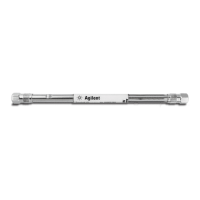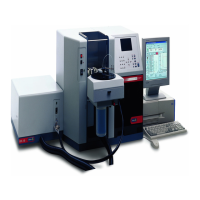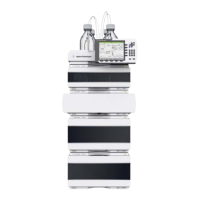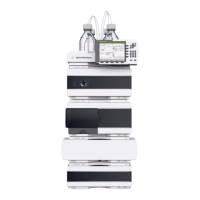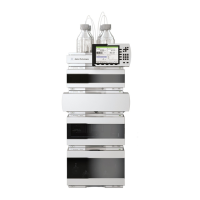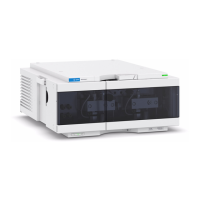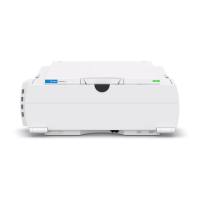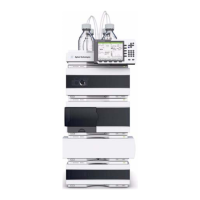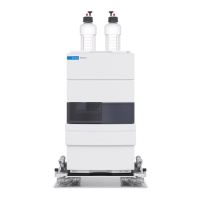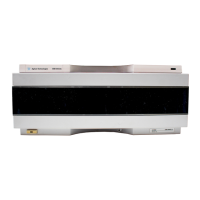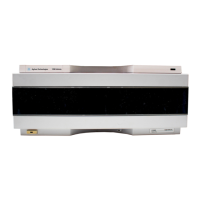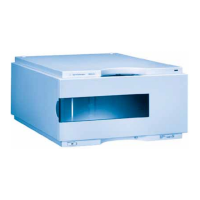
Do you have a question about the Agilent Technologies 1200 series and is the answer not in the manual?
| Type | HPLC System |
|---|---|
| Maximum Pressure | 600 bar |
| Flow Rate Range | 0.001 to 10 mL/min |
| Temperature Control Range | 4°C to 80°C |
| Pump Type | Quaternary Pump |
| Pressure Range | 0 to 600 bar |
| Injection Volume Range | 0.1 to 100 µL |
| Detector Type | Variable Wavelength Detector (VWD) or Diode Array Detector (DAD) |
| Wavelength Range (VWD) | 190 to 600 nm |
| Wavelength Range (DAD) | 190 to 950 nm |
| Power Requirements | 100-240 V, 50/60 Hz |
Explains the flow path of the pump and its components.
Details the function and mechanism of compressibility compensation.
Describes the EMF feature for proactive maintenance scheduling.
Provides an overview of the module's internal design and packaging.
Lists the main electronic components of the pump module.
Details the various electrical connectors and their functions.
Lists and describes the interfaces available on Agilent 1100/1200 Series modules.
Covers essential environmental and site preparation needs for optimal operation.
Provides key physical dimensions, weight, and environmental limits.
Outlines the operational performance characteristics and capabilities of the pump.
Guides the user through the process of unpacking and checking the pump.
Explains how to configure modules in a stack for optimal performance.
Step-by-step instructions for the physical installation of the pump.
Details how to connect modules and integrate control software.
Illustrates the flow path connections for isocratic operation.
Illustrates the flow path connections for gradient operation.
Procedures for preparing the system for initial operation.
Provides practical tips for optimal and reliable pump operation.
Offers guidance on solvent compatibility and handling.
Recommends measures to prevent solvent filter clogging.
Covers the configuration and parameter settings for pump operation.
Instructions for setting up and using the seal wash function.
Guides on adjusting compressibility settings for best performance.
Introduces the diagnostic software for instrument analysis.
Describes instrument indicators and built-in diagnostic tests.
Lists and explains common error messages and their probable causes.
Details the procedure for testing system pressure tightness.
Explains how to perform a leak test to identify system leaks.
Procedure for cleaning the Electromagnetic Proportional Valve (EMPV).
Overview of maintenance procedures and safety precautions.
Covers common repair procedures that can be done with the pump in place.
Instructions for inspecting and cleaning solvent inlet filters.
Guides on replacing inlet and outlet ball valves.
Procedure for replacing the filter cup in the multi-assembly.
Procedure for replacing the filter frit in the multi-assembly.
Steps for replacing the seal wash pump cartridge.
Instructions for taking apart the pump head assembly.
Steps for putting the pump head assembly back together.
Procedure for replacing an optional interface board.
Guides on updating or downgrading the module's firmware.
Lists parts related to the pump housing and main internal assemblies.
Details the components and part numbers for the pump-head assembly.
Lists parts for the solvent cabinet and solvent inlet system.
Identifies components and part numbers for the pump's hydraulic path.
Lists the contents of the standard basis kit for the preparative pump.
Lists the contents of the gradient kit for the preparative pump.
Describes the function and components of the main pump board.
Details the optional interface boards that can be added to the modules.
Explains the different interfaces used for communication and control.
Describes the main power supply unit and its specifications.
Provides essential safety precautions for operating and servicing the instrument.
Offers detailed information and recommendations regarding solvent usage.
